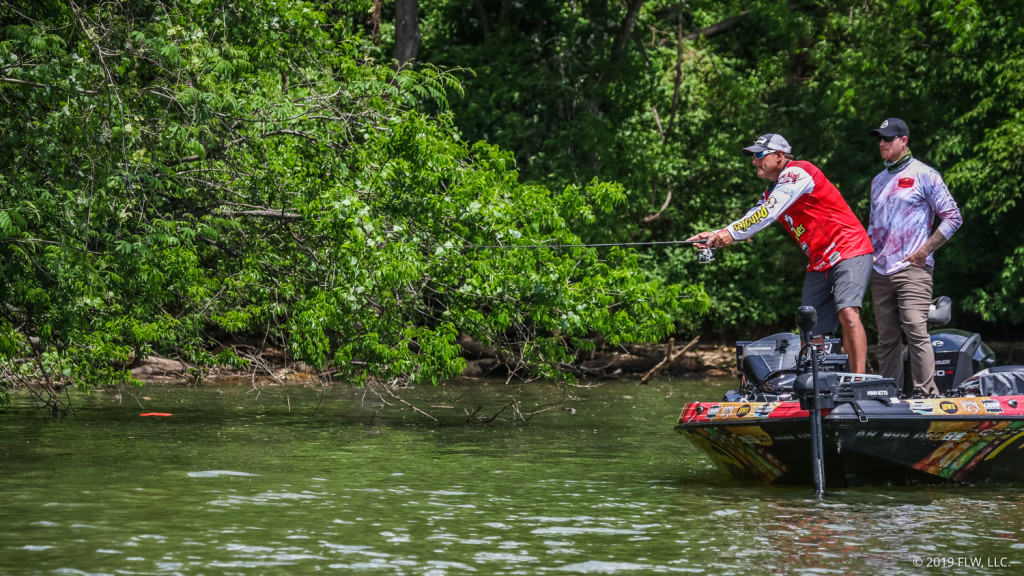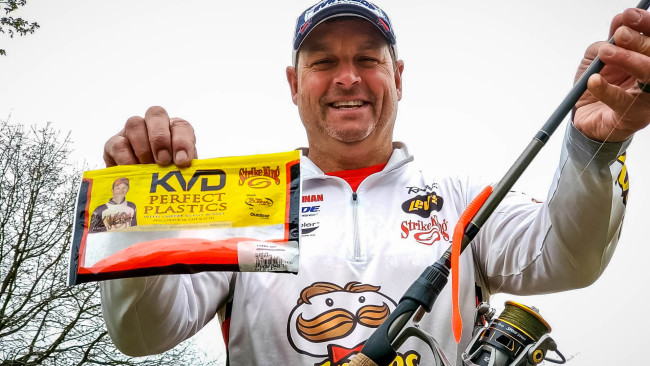A Dirt-Simple Worm Rig for the Spawn
This basic tool is great for covering water with finesse when the fish go shallow in spring

I love to power fish as much as the next guy, but around the spawn and the immediate postspawn, when I need to put fish in the boat, I often turn to a dirt-simple – and somewhat gaudy – finesse-worm rig that excels in shallow water. It’s easy to set up and skips like a dream, which could help you reach shallow bass around wood cover and docks that you might otherwise be missing.
This rig has helped me earn a lot of money in FLW events over the years, so whether or not you fish for tournament checks, consider giving it a shot in the coming weeks.

The rig
Around the spawn, I always start with a methiolate 6.5-inch Strike King Finesse Worm. Yeah, it’s pretty loud. If I’m not getting bites on a bright worm I go to something natural, such as green pumpkin.
I rig the worm Texas style with an offset worm hook and fish with a 7-foot, medium Lew's Custom Pro Speed Stick spinning rod and a Lew’s Custom Pro Speed Spin reel. Braided line makes the rig easy to skip, so I spool up 15-pound-test Strike King Tour Grade Braid and connect it to a 15- to 18-inch leader of 12-pound-test Strike King Tour Grade Fluorocarbon.
A key is to connect the leader to the braid with a small barrel swivel. The swivel isn’t there to avoid line twist as much as it is a way to add a little extra weight for easier casts and just a hair faster sink rate.
How to fish it
If the water is clear enough to see a bass on bed, the bright color of the worm certainly helps with sight-fishing, but that’s not really the point. Bright worms just seem to work this time of year. Maybe the color aggravates them a little bit, whether they’re spawning or guarding fry.
And that’s the prime time of year to fish it – during the spawn and postspawn, when bass are shallow and set up on shoreline cover. Given their location and activity, the best target areas are overhanging trees, shallow vegetation such as hydrilla or pad stems, docks, and shallow wood cover such as laydowns and stumps.
I like to make direct casts to targets or skip the worm under or past obstructions. If I think there’s a fish on a bed somewhere, even if I can’t see the bed, or if there’s an obvious piece of cover that might attract a bass to spawn next to it, I’ll let it sink right there.
Otherwise, I twitch it out from the cover, just like fishing a soft-plastic jerkbait. I’ll work it really fast, and then I’ll kill it when it gets out to the end of the cover – around the last branches of a laydown, for instance. A few years ago on Dardanelle during a Toyota Series event, I’d get to the end of the log and I’d watch those fish come up and eat it. When it was sinking, it would bring them up off that bed.
To cover more water, I don’t waste too much time fishing the worm all the way back. Rather, I keep my Pringles boat moving at a pretty good clip along the bank as I pick apart the cover. If they don’t bite within a couple seconds of me letting the worm sink, I’ll reel up and repeat. If one swirls and misses, I cast right back to the spot. That’s probably a fish on bed.
Yeah, this is a finesse presentation, but I’m often able to cover a good amount of water with it in the same kinds of places where other anglers fish a spinnerbait or a soft jerkbait. And since bass can’t resist that subtle Floating Worm in their face, it’s a good way to get a lot of bites.